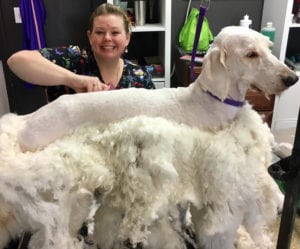To Shave or Not to Shave?

by Angie Ardolino
Many families invest a lot time and money on adopting a “hypoallergenic” dog, or a dog that doesn’t shed like a Labradoodle, Goldendoodle, or Shih Tzu. However, instead of shedding, they’ve now committed to weekly brushings and monthly trips to the groomer. Grooming these dogs start at $50 and go up to $150 depending on their size and coat. Unfortunately, many busy families don’t have the time to brush the coat thoroughly every week and that’s when matts set in.
Light matting can be brushed out, often with a little help from some good shampoo and conditioning treatment, but heavy matting close to the skin leaves a groomer with little choice but to shave.
To understand why a groomer would shave a dog, we need to understand why it is the safest option. Matting is commonly found around the joints, behind the ears, around collar and on underbelly. They are essentially clumps of tightly tangled hair that can spread throughout their body. A dog with matting may chew, scratch or bite at the matted areas, making them even worse. Oil, dirt, debris and friction all contribute to matting. The longer matting is ignored the worse it gets. A small tangle on a leg can develop into a mat that can then encase the entire leg, leading to sores and potentially cutting off circulation. We’ve seen dogs who were losing circulation to their tails and legs because of severe matting.
Why shave them?

Imagine not brushing your own hair for 3 months. Then, think about trying to get a comb from your roots to your ends without getting stuck. It hurts! The main reason the groomer will shave your dog is because it is extremely painful to demat them. Their blade needs to fit in the space between the mat and the skin. The safest and most humane option is to shave them and start over – which will not cause your dog any unnecessary pain or discomfort. If your kids don’t like your dog when he’s shaved, put them to work with a brush and comb. Pictured left is Jen a professional groomer shaving a Labradoodle who was completely matted to the skin.
In Between Grooms
There are many ways to prevent or limit matting between grooming appointments. First, get yourself a few tools to help you get the job done like a Slicker Brush, pin comb and some de-matting spray. Make sure to use a comb and pull it from their skin all the way through the coat. If you get to a tough spot you can spray the de-matting spray to help you work the tangle out. Any professional groomer will be more than happy to show you correct brushing techniques and recommend a schedule to maintain the hairstyle you prefer for your pup. Regular professional grooming is key, especially if you’re unable to comb weekly at home. The groomers at Beautify the Beast see most of their fluffier clients every 4-6 weeks and they have little to no matting; it’s very easy to achieve a cute teddy bear style on them, you just have to stay on a consistent grooming schedule.
Hypoallergenic Breeds
Here’s a list of hypoallergenic breeds that don’t shed but need to be brushed weekly(some daily) and groomed every 4-6 weeks to prevent matting and other skin conditions from developing:
- Airedale Terrier
- Tibetan Terrier
- Maltese
- Shih Tzu
- Brussels Griffon
- Portuguese Water Dog
- Soft-Coated Wheaten Terrier
- Poodle (all sizes)
- West Highland White Terrier
- Bichon Frise
- Kerry Blue Terrier
- Havanese
- Chinese Crested
- Scottish Terrier
- Schnauzer (all sizes)
- Irish Water Spaniel
- Carin Terrier
- Labradoodle
- Goldendoodle
- Yorkshire Terrier
- Silky Terrier
- Bouvier Des Flandres
 Angie Ardolino is the co-owner of Beautify the Beast and lives on a 3 acre farm in Lutz, where she rescues and cares for farm animals and dogs. For more information visit, www.beautifythebeast.com
Angie Ardolino is the co-owner of Beautify the Beast and lives on a 3 acre farm in Lutz, where she rescues and cares for farm animals and dogs. For more information visit, www.beautifythebeast.com
The post To Shave or Not to Shave? appeared first on Beautify the Beast.